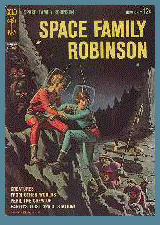
The FOUR COLOR series produced over 1200 issues, but by the early 60s Dell wanted out of the comic book segment, and transferred the rights of their various properties to Western.
The Robinsons consisted of Mom & Dad and their teenage son and daughter , Tim and Tam. They lived on a very large space ship that had somehow become lost. The stories were fairly sophisticated for the media, dealing with science and nature. On the otherhand, they were simply blocked , that is, unsophisticated graphically . The artwork was precise, but not spectacular. It was the work of Dan Spiegle, a longtime artist for Western. The covers were always painted, probably in acrylic, by an artist I have yet to identify. These were common on Gold Key publications, and gave the line a very classy look, at least to a kid. Compared to other comic books of the era, the were elegant!


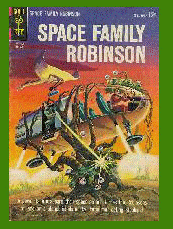
Gaylord Dubois wrote most of the stories for the comic's fifteen year run. Other titles in Gold Key's stable were these originals: MAGNUS ROBOT FIGHTER 4000 A.D., about a man on a crusade against dependance on machines; DR SOLAR MAN OF THE ATOM, about a nuclear hero; and MIGHTY SAMSON set in a post holocaust New York. These concepts were so far above the competition that they are still readable today. In 1963, the hot comics were Batman, Superman, and newcomers Spiderman and The Fantastic Four. Looking at contemporary issues of those titles is painful , although nostalgic.
At that time Gold Key comics had 32 pages with no advertising. The inside covers were even devoted to "fun facts" and the like. This followed the FOUR COLOR formula. The covers read "Now Only 12 cents" or "Still only 12 cents". This is rather strange, because most comics were still 10 cents, except for late issues of FOUR COLOR which were a whopping 15 cents. When Gold Key took over for Dell, they were priced , from the beginning, at 12 cents. They would not reach 15 cents until 1968. Within months the two giants of the industry, Marvel and DC, raised their prices to 12 cents, but their non-advertising content was always lower, at around 23 to 24 pages.
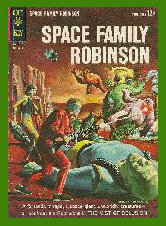
Gold Key also had the licenses for many, if not most, television and movie properties. On these they usually used photo covers. If it was movie or TV related, they had the rights to it, it seems. The only exception I can think of is DC's "Heckle & Jeckle" series.
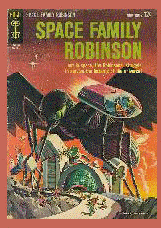
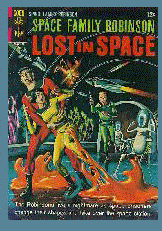
After about 18 issues, in mid 1966, the Robinsons stumble unto a group of 12th Century Englishmen who were abducted by aliens. They've been frozen all this time, and the plot really stretches when it's discovered that the leader of the group is an ancestor of the Robinsons. The plots started to sink after this. (The ancestor was returned after a few months to his native home, via a convenient time warp and the rest of the crowd were left to homestead a new planet.) No sooner had this somewhat dubious storyline ended than another one began, a terrible cycle of stories which placed the Robinsons on ancient Mars and then Atlantis just prior to its sinking into the sea.
After a couple of years of this, DuBois settled down and began writing more solid (at least for the comic book genre) science fiction. The series would last for another 30 or so issues, spaced irregularly over the next decade. Gold Key's production values declined though, and soon their ad count was as high as all the rest. The physical size of the pages got smaller , as did the paper quality . Painted covers were still used, but they were not done nearly as well as the early ones.
In the early 70s the title changed again, making a full circle of sorts, to SPACE FAMILY ROBINSON LOST IN SPACE ON SPACE STATION ONE.
© 1998 John Barrett